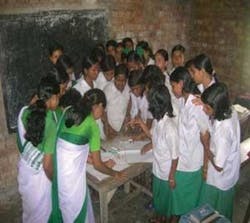Rethinking Women, Girls and Water Supply and Sanitation
By Ned Breslin, Rajashi Mukherjee and Mark Duey
Improving water and sanitation programs increasingly must rely on women as both subjects and catalysts of sustainable community efforts, according to Water For People
The international water supply sector has rightly focused on potential impacts of improved water supplies on the lives of women and girls. Attention emphasizes potential time savings realized by water carriers (women and girls) when new systems are installed closer to home. Increased concentration on schools-based programming has been driven by a desire to keep girls in school during teen years when dropout rates can soar, especially at schools where facilities are unavailable to girls who are menstruating. And some work has focused on the empowering potential of women in leadership roles on local water committees, suggesting that women’s involvement not only helps improve system operations (as they suffer the most from project failure) but also on increased power and prestige that can result from successful management of a water project.
Improving Data & Results
Sadly, there’s little data to back the sector hopes outlined above. Water supplies closer to home and operational do have the potential to dramatically reduce the collection burden of girls and women, but project failure is considerable worldwide. The Financial Times in an April 20, 2009 article attempts to quantify project failure in rural Africa, estimating that over 50,000 water points are broken (at an estimated value of between $215-$360 million in wasted investment), thus forcing women and girls back to distant and unprotected water sources. The sector would have a greater impact on the lives of women and girls if we could actually implement more sustainable projects, and monitored the projects it installed so adjustments can be made over time as problems are identified and resolved – and modifications made to future programming based on real insight into previous work.
Empowering women and girls through water supply and sanitation can also be better achieved if we looked at ways to access their skills and knowledge in new ways that helped transform them from what we perceive as passive recipients of development support who can be “liberated” by establishing (for instance) quotas for women on committees to an approach that actually recognizes women and girls as active agents of change if we only listen to their voices and let them drive their own development.
India’s Empowering Effort
In West Bengal, India, women and girls are often crowded out of development debates by men. Water For People has developed strong partnerships with a range of local NGOs who innovatively challenge such conventions – including Sabuj Sangha, Sundarban Social Development Centre, Rural Aid and Nishtha. Monitoring results from work supported by Water For People suggested that the improved latrines being installed at schools weren’t always being used by girls. Further analysis found that the decision by schools to locate latrines in the front of the school – as a show piece highlighting school infrastructure improvements – was a deterrent to girls as the cultural stigmas surrounding sanitation are considerable in India. Girls, in short, didn’t want to walk in front of the entire student body on their way to the toilet. Other weaknesses in design included a lack of privacy for girls who were menstruating and limited/no facilities for girls to discreetly dispose of used menstrual materials.
Instead of redesigning the facilities with these insights, Water For People’s partners started a pilot program that turned girls into engineers. The basics of latrine design was presented to girls who were then given freedom to design the interior of the sanitation blocks in ways they would find met their needs.
Actual designs vary from school to school, but the principles of their designs have a great deal of commonality. First, the girl engineers placed the new latrines at the back of the school, and many didn’t decorate the exterior of the latrines at all to make them less noticeable still. The interior included taps at multiple levels so that blood stains can be cleaned effectively, mirrors that allow girls to verify that their clothing is blood-free and private stalls to afford girls the privacy they desire.
The new latrines have facilities to dispose of menstrual pads (it should be noted that not all girls use disposable pads) safely and discreetly into an incinerator. Shelves to place cloth/pads and door hooks to hang clothing while they cleaned themselves were also suggested. The designs were then implemented at the schools with the girls providing project supervision support to ensure their designs were actually followed.
Although anecdotal, what’s most surprising is how girls at schools whose designs were implemented are far more vocal than their counterparts at schools where design of the sanitary blocks wasn’t done by girl pupils. Girls are proud of their work and see their ideas accepted by development agencies and school administrations. They speak of how they’re now sanitation experts, how they use their toilets “all the time” and how they’re spreading the word in the broader community about the importance of sanitation. A group of girls at one school actually took over a recent meeting and refused to let the boys speak until the very end of the meeting, which one teacher commented afterwards was unprecedented. In short, they become ambassadors for better sanitation and, by extension, water supplies.
Taking Charge in Honduras
Another strategy being employed by Water For People is to actually let women manage implementation finance. In the communities of San Antonio de Cortes, Honduras, Water For People directs the funds for the construction of school infrastructure (augmented by municipal government funds) to Parent-Teacher Associations (PTAs) to manage. This strategy, called “direct transfer” leads to real empowerment. Water For People partners are no longer in the position of implementing and managing finance on behalf of the community. Instead, communities are in control of the finances and thus in charge of the project. The PTA contracts out the services they need, and negotiates prices in a competitive way, thus establishing their relations with outside agencies and companies they’ll undoubtedly need in the future when spares, technical support and other services are required to keep their system operational.
This program is particularly powerful in putting women in real charge of their development processes. “The experience has been great for us,” said Sara González, President of the PTA in Los Potrerillos, San Antonio de Cortes. “In the beginning we had some problems with the contractor that we selected because he was busy somewhere else. We were ready to begin construction and three different times he told us he was ready to begin but did not show up. He was holding up our project, so we explained to him that we could not work like that and we ended up firing him and selecting a different contractor. We went through the selection process again and hired a parent who has a child in our school to lead construction. It was a real learning experience for us.”
Community Water Boards in Honduras tend to be dominated by men but PTAs are predominantly made up of women. As this program grows it will be important to see whether allocation of implementation funds to the PTA leads to a push from men to start joining and dominating this group as well. While not simpler, the direct transfer strategy has more impact in the long term: PTA management of the construction process builds members’ confidence and skills, which can help them organize more improvements to their communities.
“I feel well-prepared now to be able to implement another project,” said Ms. Gonzalez. “Seven PTA members in our community received training on how to manage funds and we learned a lot …[N]ow, we are considering doing a small project to repair the roof of the school on our own because it has too many leaks when it rains.”
Local government officials also like the direct transfer strategy: “Community members know exactly what the true cost of their [school improvement] project is and then place a value on it,” said Tulio Méndez, municipal water & sanitation technician of San Antonio de Cortes.
Conclusion
Water and sanitation can have a significant impact on girls and women if programming is focused on transferring real responsibility to women and girls rather than just assuming they’ll benefit from sound work. The sector certainly needs to improve operationally so improved systems do in fact function over time and bring lasting benefits to all, while reducing collection burdens of girls and women. Yet Water For People is showing there are other ways to transform lives through programming designed to give real authority to women and girls from the start of a project. Time will tell what result this actually has in practice, but having girls design their own latrines and women manage implementation finance show promise in the field.
Authors’ Notes:Previously international program director since 2006, Ned Breslin was named in May as CEO of Water For People, a Denver, Colorado, USA-based international development organization founded in 1991 that supports safe drinking water and sanitation projects in developing countries. Rajashi Mukherjee is Water For People’s country coordinator in India. From Honduras, Mark Duey is SWASH+ Central America program coordinator. Funded by the Gates Foundation and Global Water Challenge (of which Water For People is a member), the School Water Sanitation and Hygiene + Community Impact (SWASH+) effort is a five-year program begun in 2007 to develop related sustainable programs in developing countries. Contact: +1-303-734-3490 or www.waterforpeople.org

